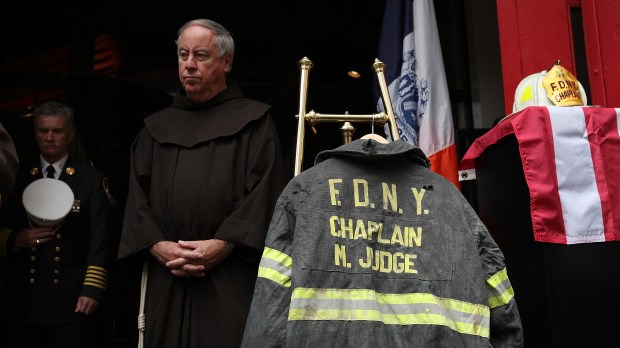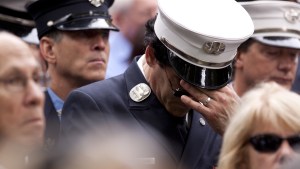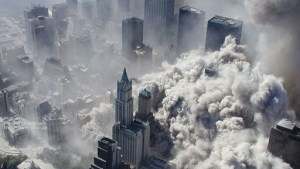Franciscan Fr. Mychal Judge might be the best known priest associated with the September 11, 2001, terror attacks on America. A New York City Fire Department chaplain, he was killed when he was ministering to a victim at the base of the Twin Towers and was hit by falling debris. He is listed as the first certified fatality of 9/11.
But like firefighters running into the Twin Towers as thousands tried to escape the danger, many Catholic priests rushed to the scene on that tragic day, blessing the bodies of victims, or offering pastoral care to survivors and the bereaved and moral support for first responders. Many more around the city held down the home parish, where they did everything from presiding over prayer vigils to counseling the fearful to comforting those whose loved ones were missing. Some priests saw with their own eyes what was happening from a distance and prayed a conditional absolution of the sins of those whose lives were in peril.
Msgr. Robert J. Romano was about to celebrate a funeral Mass at St. Bernadette’s, a parish in the Dyker Heights section of Brooklyn, when he heard about the first plane crash. By the time the funeral was over, much more had transpired, and the family of the deceased was urging Msgr. Romano, a chaplain for the New York Police Department, to “go and help those poor people” in lower Manhattan.
He changed into his police uniform, and a local police precinct car ferried him into Manhattan. As he was crossing the Brooklyn Bridge, Msgr. Romano saw many policemen and firemen running across the span into Manhattan and thousands of civilians walking toward Brooklyn on the opposite side of the bridge.
He checked into local hospitals, which had mobilized large staffs to handle an influx of wounded. But not many came in, as most of those working in the Twin Towers either evacuated on time or were killed in the skyscrapers’ collapse.
So the 51-year-old chaplain returned to Ground Zero, where the rest of the day’s work was done, as he put it, “by the seat of your pants.” Nothing in his life had really prepared him for what he was about to see, including bodies on the ground of persons who had jumped from the upper floors of the burning towers, in desperation.
Both the North and the South Tower of the World Trade Center had collapsed by the time Romano arrived on the scene. He was struck by the prevailing quiet, which he attributes to the atmosphere being full of particulate matter from the buildings’ collapse. He likened it to being in a blizzard, which muffles most sound. It was so quiet that he heard the clicking of a traffic light that must have been operating on a battery, as all electrical service to the area had been knocked out.
A classmate from seminary days, fire chaplain Msgr. John Delendick, told Romano about Fr. Judge. Romano went to nearby St. Peter’s church, where firemen and policemen had carried the Franciscan friar, and the police chaplain blessed his body.
He then split his time between offering assistance at the site of the towers and at Police Headquarters at 1 Police Plaza. A family assistance room was being set up for relatives of missing officers. Romano ended up being there the whole night, witnessing happy reunions of police officers who made it out alive and being there for families who would not see their relatives alive again. In the morning, he offered to celebrate Mass right there, because 20 of the 23 police officers who had died were Catholic.
That was 23 of the total of 2,996 who perished in the attacks on the United States that day. A separate police force for the Port Authority of New York and New Jersey, which was responsible for the World Trade Center, lost 37 members. The Fire Department of New York suffered 343 losses.
“That was the beginning of saying Mass every day at 1 Police Plaza,” Msgr. Romano said. “We did that for about two months.” Then every Sunday he would say Mass at Ground Zero for officers at the time when the shifts would change. He said the congregation grew from 17 officers on the first Sunday after 9/11 to about 1,000 people by the time workers took the last piece of steel out of the site, the following spring. Families of victims and even the police commissioner and police chief would attend the weekly Mass.
“Then we’d go over and have breakfast at the Salvation Army tent,” he recalled. “And the families would be there. They were so happy to come to that Mass.”
Rich spirituality
Msgr. Romano still had his parish duties to attend to, but any time a body was found during the long months of recovery at Ground Zero, he would get a call.
“I would rush back, and we would escort the body to the morgue,” he said. “It was a very touching thing because they would line up — firemen, police officers, civilians — and when the body was brought up out of the pit on a large ramp, we would walk up that ramp, and they would carry the body, and everyone would stand at attention and salute. Then I would say some prayers and bless the body.”
In spite of the tragedy of September 11, 2001, Msgr. Romano, now assistant chief chaplain of the NYPD, sees the rich spirituality that came out of it. “How many people came to me saying ‘I want to go to confession.’ How many people came back to church. How many people still go to church because of that,” he said.
But 9/11 lives on in the effects it’s had in people’s lives, including Msgr. Romano’s. Now 71, he said he still suffers from post-traumatic stress and insomnia. “I can’t watch any television shows that show the building or talk about it,” he said.
Since that day, there have been hundreds of police officers, firefighters and other first responders who have died as a result of health problems stemming from the toxic atmosphere at Ground Zero. Just last week, Romano said September 8, “I buried a cop who died of 9/11 disease.”
He stays in touch with families of those who perished, such as a police officer’s son who was baptized just 10 days before tragedy hit. Most of all, Msgr. Romano said, “we never forget.”
Seeking solace
Bishop Frank Caggiano of Bridgeport, Connecticut, was a pastor in the Diocese of Brooklyn at the time of the attack. His parish, St. Dominic’s in the Bensonhurst section of Brooklyn, ended up having 12 funerals that fall — one of many parishes that suffered losses.
“A significant number of people in my parish worked downtown, in the Wall Street area, including young people,” he said. “From that section of Brooklyn — which is not far from where I grew up — you jump on the N train, you jump on the R train and you make a straight line into the Wall Street area, the financial district. A lot of young people, that’s how they started their careers, coming out of college or graduate school. There was a whole exodus every day coming out of Brooklyn into Manhattan and back.”
At about 3 o’clock on the afternoon of September 11, Bishop Caggiano said, people began streaming into the church, and he exposed the Blessed Sacrament for Eucharistic adoration and a time of quiet prayer.
“Literally, there were hundreds of people out the door,” he said. “Many of them were relatives who were so worried and so anxious about their spouses, their brothers and sisters, their children, down in Manhattan: what had happened to them, if they had gotten hurt; they saw images [on television] of people walking across the Brooklyn Bridge, covered with soot and dust.”
At one point, he said, he had to leave the church for five minutes “to take a breath.”
“I stood at the corner of 20th Avenue and Bay Ridge Parkway, and for the first time of my entire life — the only time in my entire life — I stood in Brooklyn with absolute silence. There was not a car moving, there was not a subway running, there was nothing. And that eeriness of the silence was like a bat hitting me over the head.”
The city’s subway system had been shut down, and there had been a federal order to ground all aircraft, to ensure there were no further terrorism plots in the works.
But he admitted that he felt helpless in some regards. “People were asking fundamental questions — the most basic being ‘How could this happen? How did God allow this to happen? Why?’ And of course, every attempt at answering the question sounded trite and packaged. And then for the first time in my life I realized that the best answer is no answer. You just had to sit and pray with them, because there is no answer at that point that is going to address the real questions of their heart, which is the unsettled anxiety of ‘What is my life now? Is my husband coming home? Is my son coming home?’”
“Whoever could have imagined that, except for the Revolutionary War and the Civil War, war would be brought into our midst?” Bishop Caggiano mused. “We always fought wars in distant lands. And a whole new type of war. Now it’s become part of the fabric of our lives — sadly.”
Reverence for the body
Meanwhile, Fr. Peter Byrne was pastor of Immaculate Conception parish in the New York borough of Staten Island. He is now an auxiliary bishop of the Archdiocese of New York.
The principal of Immaculate Conception school lost a brother who was a fireman that day, and a parishioner who was a Port Authority police officer was killed. In his free time, Officer Donald Foreman, 53, had coached basketball and was the director of Immaculate Conception School’s sports program. He also volunteered at a homeless shelter.
Fr. Byrne helped at the temporary morgue near Ground Zero to bless bodies or body parts that were found and brought in. But he said there were so many priests and deacons who volunteered for that service that he ended up doing only one shift.
“They would bring plastic bags in on gurneys and we would say prayers over them, the remains,” Bishop Byrne said. “Then they’d bring the bags into another room, open them up and examine the contents. Oftentimes, there were body parts, sometimes just a shoe. One of the priests saw them taking somebody’s head out of a bag.”
The parish had a Memorial Mass for Donald Foreman, since no body was found. Almost a year later, however, the morgue “called me up and said they had identified the remains. Out of earshot of the family I asked what we were burying, and he said ‘31 bones.’ So we had a casket and a funeral for him, with the remains.”
Ministry of Presence
One of the iconic images of 9/11 was the thousands of homemade posters with photos of missing persons on them. Desperate families who didn’t hear from their loved ones in the first few days after the attack posted notices all over the city, hoping that the relative might just be lost or disoriented or unconscious in hospital.
But hundreds of relatives had to face the very real possibility that their loved ones would be found dead amid the rubble of the Twin Towers.
Fr. Thomas Berg had just been ordained a priest the year before and was living in Westchester County, north of the city. He and fellow priests watched television with a sense that they needed to do something to help out. They got permission from their superior to go to New York City two days after the attack. By that time, a center had been set up for relatives of missing persons to report their loss to authorities. Fr. Berg and his confreres met Red Cross representatives, who gave them a crash course in being disaster response chaplains and assigned them to this center.
“They quickly set up 200 or so tables for detectives and FBI agents, etc., so that families of those missing could come in, talk with a detective, give information on the missing, at which point, they’re told to go home and bring back either dental records or a strand of hair or something they can take DNA from,” Fr. Berg said. “People were waiting on both sides, up Lexington Avenue and across 25th Street to eventually get in. The building takes up a whole city block.”
He said the priests “just started working the line, and you just figured it out, what to say. You’re talking to people who are in absolute shock, so [we’d say] ‘Who are you missing? Tell me about that person. Could I pray with you? Tell me what I can do for you,’ that kind of simple stuff. Some people had a lot of emotion. Some people were crying. Some people couldn’t talk. Some people welcomed our approach. I remember a man. I just looked into his face. He must have been like 35. I did my questions. And his face was just stone grey. And he just stared back at me and didn’t say a word. His whole world had just disappeared, and I could have been talking to a wall.”
The ministry of presence, as Fr. Berg calls it, was nothing dramatic, he emphasized, but important nonetheless. “It was really just being with people, literally standing with people,” said Berg, who is now professor of moral theology at St. Joseph’s Seminary in the Archdiocese of New York. “I remember praying with two sisters who were from the Dominican Republic who had married two brothers, and the brothers worked in the kitchen at Windows on the World [the restaurant at the top of North Tower], and they were gone. They were Catholic, and I remember sitting and praying with these two, and a female Dominican police officer came over and prayed with us too.”
At the end of a very long, full day of ministering to people, as he was about to leave, a detective called to him, “Father you’re a Catholic priest, right? There’s a woman over there who wants to talk to a priest.”
“So I go over and talk to her,” Berg recounted. “It was just the most heartbreaking thing. The detective came over with me. Her husband and daughter worked in the Twin Towers, and they were both gone. The question she had for me was like, she just wanted to know how to do a memorial service. ‘How do I start making funeral arrangements?’ At which point, she broke down crying. I broke down crying. The detective breaks down crying. The detective and I just huddled and held her. It was scene after scene like that.”
Christ’s presence
A firefighter who was in the midst of the tragedy at Ground Zero and later became a priest, Fr. Thomas Colucci, recognizes that some people question how an all-good and loving God could have allowed the horrific attacks to take place. In answer to people who ask “Where was God that day?” he points to the “hands and feet” of Christ.
“You saw the Body of Christ in the workers who responded that day,” Fr. Colucci said, “in the people that died, but also all the rescue workers who showed up: police officers, firefighters, EMS … ambulance drivers, nurses, doctors. Everybody was responding that day.”
No doubt he would add the priests who provided a ministry of presence, whether at Ground Zero itself or anywhere else. Because Ground Zero took place wherever a family was affected by the tragedy. And so many families were.



